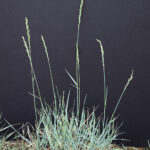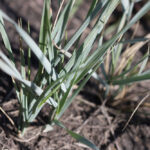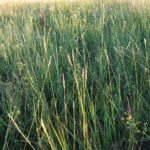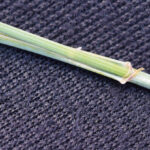Western Wheatgrass
Pascopyrum smithii
General Description
Western wheatgrass is a native cool-season perennial grass that grows from strong rhizomes. It is regularly found in patches mixed with other species in native plant communities. Smooth stems grow to 20 to 100 cm (8 to 39 in) tall and are very erect. The leaves are rigid, flat, 6 mm wide, blue-green with prominent veins. Leaves grow at about a 45 degree angle to the stem. Western wheatgrass plants are often seen growing without seedheads/stems.
Type
Native grass.
Origin
Mixed Grass Prairie of North America.
Longevity
Long lived.
Use
Pasture, hay, reclamation.
Optimal Time of Use
Spring, summer, fall. Cures well of the stem so is suitable for fall stockpiled grazing. Harvest for hay by heading for best quality.
Recovery After Use
Western wheatgrass should be allowed to reach 15 cm (6 in) of growth before grazing in spring. It usually responds favorably to rest rotation or deferred rotation grazing systems. Recovery can occur within 60-80 days in cultivars.
Palatability/Nutritional Value
Western wheatgrass is considered good forage and is palatable to livestock and wildlife. In June digestibility is 60% with crude protein around 14%. Digestibility on unharvested western wheatgrass remains the same through fall with crude protein levels dropping to between 7.5- 9.5%. Stockpiled regrowth does maintain high quality (11-16 % CP). Western wheatgrass provides nutritious winter pasture and hay.
Annual Precipitation min/max (mm)
300mm / 510mm
Drought Tolerance
Excellent tolerance. Plants will shut down, but will regrow when moisture returns.
Flooding Tolerance
Can stand up to 5 weeks of spring flooding.
Winter Hardiness
Excellent hardiness. Western wheatgrass’ cold hardiness is comparable to crested wheatgrass and Russian wildrye.
Soil Texture Preference
Suited to all soil textures but grows best on clay to loamy soils. Naturally found on moist to dry slopes and can often be found where water pools in the spring. Often found on solonetzic soils.
Erosion Control
Effective erosion control. However, full cover will take time as seedlings must first establish and then rhizomes spread.
Salinity Tolerance
Slight to moderate tolerance.
Acidity Tolerance
Not recommended for acidic soils.
Alkalinity Tolerance
High tolerance.
Seeds per kg
253,000 seeds/kg (115,000 seeds/lb)
Suggested Mixtures
Native species mixes; legumes and/or tame bunchgrasses for grazing; Western wheatgrass works well in mixtures but creeps aggressively so should be kept to a low percentage in a seed mix.
Ease of Establishment
Western wheatgrass is relatively easy to establish, but seedlings tend not to be very vigorous and stands can take several years to become fully established through rhizome development.
Competitiveness
Can be competitive as it becomes established, spreading mostly by rhizomes. The percentage in seed mixtures should be kept low to prevent western wheatgrass from dominating stands.
Management Considerations
A mixed stand helps reduce the chances of seeded western wheatgrass becoming sod-bound. Manage grazing for adequate recovery. Western wheatgrass works well in a stockpiled grazing system.
British Columbia Rangeland Seeding Manual, Saskatchewan Dryland Forage Species Adaptation Tool, AAFC Field Guide to Selected Native Forages, USDA Plants Database, Alberta Forage Manual, Manitoba Forage Adaptation and Comparison Guide
Western wheatgrass is not typically found in the native grassland communities in this region.
Western wheatgrass is not typically found in the native grassland communities in this region.
Western wheatgrass is found in native grassland communities in the Peace-Liard region, sometimes with slender wheatgrass, western porcupine grass and northern wheatgrass.




